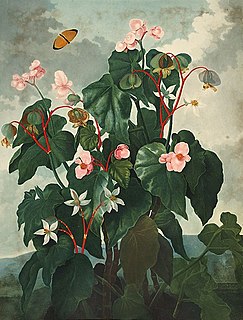
Begonia is a genus of perennial flowering plants in the family Begoniaceae. The genus contains more than 2,000 different plant species. The Begonias are native to moist subtropical and tropical climates. Some species are commonly grown indoors as ornamental houseplants in cooler climates. In cooler climates some species are cultivated outside in summertime for their bright colorful flowers, which have sepals but no petals.
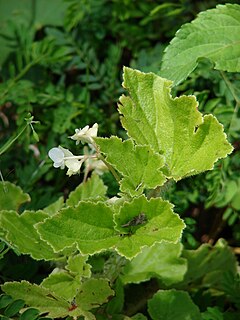
Begoniaceae is a family of flowering plants with two genera and about 2040 species occurring in the subtropics and tropics of both the New World and Old World. All but one of the species are in the genus Begonia. There have been many recent discoveries of species in the genus Begonia, such as Begonia truncatifolia which is endemic to San Vincente, Palawan. B. truncatifolia is smaller in size than other species of the genus Begonia and this new species is proposed Critically Endangered by standards set by the IUCN. The only other genus in the family, Hillebrandia, is endemic to the Hawaiian Islands and has a single species. Phylogenetic work supports Hillebrandia as the sister taxon to the rest of the family. The genus Symbegonia was reduced to a section of Begonia in 2003, as molecular phylogenies had shown it to be derived from within that genus. Members of the genus Begonia are well-known and popular houseplants.

The Philippine warty pig is one of four known species in the pig genus (Sus) endemic to the Philippines. The other three endemic species are the Visayan warty pig, Mindoro warty pig and the Palawan bearded pig, also being rare members of the family Suidae. Philippine warty pigs have two pairs of warts, with a tuft of hair extending outwards from the warts closest to the jaw. It has multiple native common names, but it is most widely known as baboy damo in Tagalog.
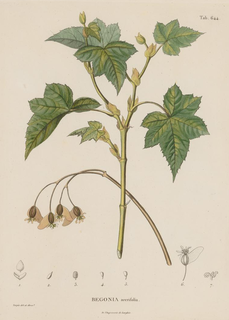
Begonia acerifolia is a species of plant in the family Begoniaceae. It is native to Ecuador, Peru and Bolivia. Its natural habitats are subtropical or tropical moist montane forests and subtropical or tropical dry shrubland. It is threatened by habitat loss.
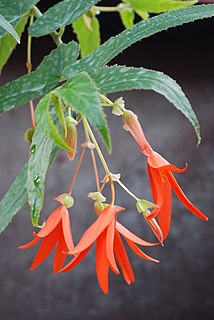
Begonia boliviensis is a plant in the begonia family, Begoniaceae, which was introduced to Europe in 1864 by Richard Pearce who discovered it in the Bolivian Andes, although the plant had previously been identified by Hugh Weddell in the same region but not introduced.
Cyrtandra cleopatrae is a species of plant in the family Gesneriaceae endemic to the Philippines. It is a tropical shrub having recaulescent inflorescences composed of multiple purpled flowers that emerge on the plant stem from stubby shoots. It was first collected for science during a 1998 expedition sponsored by the Royal Botanic Garden Edinburgh, from a location in Palawan called Cleopatra's Needle (elev. 1550m), thus the specific epithet "cleopatrae". The taxon was first published in the Edinburgh Journal of Botany in 2001.
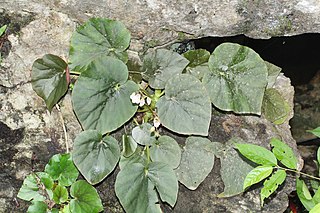
Begonia elnidoensis is an endemic species of Begonia discovered in El Nido, Palawan, Philippines. The species was compared to Begonia wadei, in that both species have thick-trunked stem, differing in the widely to very widely ovate or subtriangular leaves, with the latter having obliquely ovate leaves, 3-4 secondary leaf veins where the latter has 6 on each side of the midrib, with glabrous petioles compared to latter having puberulous to tomentose, an inflorescence measuring 20–40 cm in length compared to only 6–20 cm, and the differently-sized bracts and capsules.
Begonia balangcodiae is an endemic species of Begonia discovered in Sagubo, Kapangan, Benguet, Philippines. The species was allied to B. esculenta Merr., from which it is distinguished by its cordate leaf base and white tepals, while the latter's leaf base is not cordate and has a vermilion-colored tepals. On the same hand, this species resembles that of B. leucosticta Warburg, differing from the latter on cordate leaf base versus subcordate leaf base, and larger tepals ranging in size from 12–18 mm long in pistillate flowers versus the latter's 3–5 mm. Additionally, this species is similar to B. negrosensis Elmer, in that it has lanceolate, glabrous leaf compared to that of latter's obovately oblong and sparsely hairy leaves, and white to greenish tepals, versus that of latter's pinkish tepals.
Begonia quinquealata is an endemic species of Begonia discovered in Salakot Falls, Napsan, Puerto Princesa City, in northern Palawan, Philippines. This species, along with B. suborbiculata Merr., are the only two known species in the Philippines with 5-winged capsules. Unlike any other member of Begonia sect. Baryandra, B. quinquealata is very distinctive for being a densely hairy herb with long creeping rhizomes. It differs also from B. suborbiculata in that it has thickly chartaceous, widely ovate leaves that have uniformly green upper leaf surface, densely velutinous, with denticulate leaf margin, outer tepals, and red scabrous ovary and capsules.
Begonia tabonensis is an endemic species of Begonia discovered in Tabon Cave, Lipuun Point, Municipality of Quezo, in Palawan, Philippines. This species resembles B. mindorensis Merr., widely ovate and uniformly green leaves, and inflorescence with sessile glands. However the two species differs on several characteristics: Begonia tabonensis have shorter petioles(10 cm long), smaller leaves(4-8 x 4–6.4 cm); deciduous, chartaceous, glabrous or very sparsely glandular bracts; and slightly pointed, crescent-shaped ovary wing; whereas, B. mindorensis have longer petioles(25 cm long), larger leaves(10-15 x 6-10 cm); persistent, coriaceous, densely glandular bracts; and acute, triangular ovary wing.
Begonia tenuibracteata is an endemic species of Begonia discovered in Salakot Falls, Napsan, Puerto Princesa City, in northern Palawan, Philippines occurring on mossy boulders along road cut in shaded, wet lowland forest. This species, along with B. mindorensis, produces the unusual, conspicuous, persistent bracts on the inflorescences. However, it sharply distinct from the latter due to its ovate to lanceolate bracts, which are hyaline, membranaceous, glabrous or with very sparse sessile glands where the latter have widely to depressed ovate bracts that are coriaceous, densely clothed with sessile glands. Additionally, B. tenuibracteata differs by the congested rhizomes with internodes only to 3 mm long; with shorter petioles ; velvety upper leaf surface; shorter inflorescence ; and fewer stamens (40–50); whereas B. mindorensis have 20 mm long rhizome internodes, petioles 10–25 cm long, glossy upper leaf surface, inflorescence over 35 cm long, and up to ca. 70 stamens
Begonia adamsensis is an endemic species of Begonia discovered in Adams, Ilocos Norte province, Luzon, Philippines occurring at an altitude of 308 m above sea level. The species broad-based leaves that are peltate, with a glabrous peduncle, an acuminate tip and nearly entire margin, resembled that of Begonia hernandioides. However, there are differences, in that B. hernandioides had red-colored stipule that is broadly ovate, the petiole and abaxial lamina is pubescent, and the peltate leaves are elliptic.
Begonia beijnenii is a species of flowering plant in the family Begoniaceae, native to the island of Palawan in the Philippines.
Begonia pavonina, or peacock begonia, is a species of rhizomatous plant in the family Begoniaceae. It is endemic to the dim understory in the montane forests of peninsular Malaysia.
Begonia cabanillasii is a species of flowering plant in the family Begoniaceae, native to the island of Palawan in the Philippines.

Begonia caramoanensis is a species of flowering plant in the family Begoniaceae, native to the island of Luzon in the Philippines.
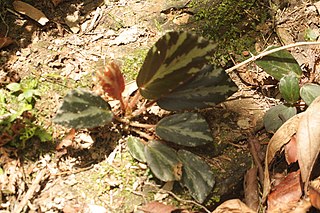
Begonia truncatifolia is a species of flowering plant in the family Begoniaceae, native to the island of Palawan in the Philippines.
The Philippine Taxonomic Initiative (PTI) is a private Philippine research institute and non-profit organization located in Palawan.
Danilo Tandang is a Filipino botanist, working in the National Museum of the Philippines, Philippines







